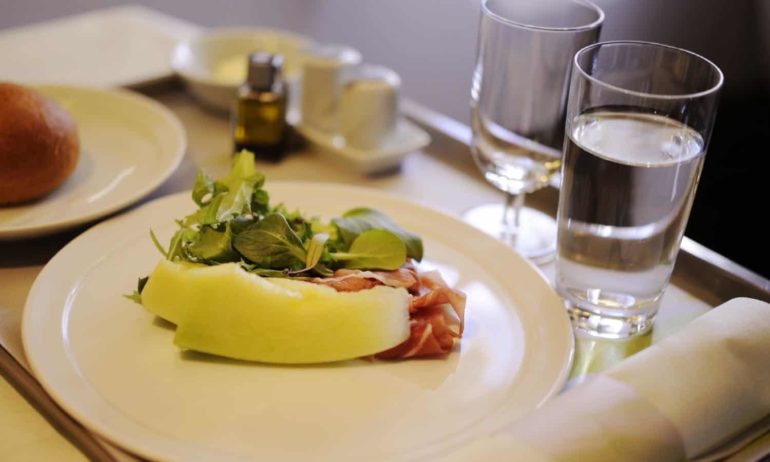MINT is a premium airline service offered by JetBlue on flights across the United States from either New York or Boston on the east coast, to either San Francisco or Los Angeles on the west coast. There are also options to and from Barbados and Aruba in the Caribbean. MINT provides faster check-ins, comprehensive entertainment, luxury seating options, and a curated fine dining inspired menu created specifically for air travel. Executive Chef Brad Farmerie of Saxon + Parole and Public restaurants in New York, has collaborated with JetBlue to create a menu that raises standards for what people expect from airline food while addressing the challenges of such a limited setting. Farmerie explains to Food Tank why this project is special and what diners can expect.
Food Tank (FT): What are some of the biggest challenges to making and serving great food on a plane?
Brad Farmerie (BF): First of all, I’m quite lucky. JetBlue as a company is very open minded and likes to give people, including me, the freedom to work under very few constraints. That is not the case with every airline. When I first started conversations with JetBlue, they had never offered meal service on their flights. So when developing MINT, they had a framework for what it would look like but were open to suggestions and collaboration to make it the best program it could be. This gave me some freedom to also achieve my own goals – bringing in bright colors, fresh flavors, texture, seasonality, and memorable touches to in-flight food. I thought that we could turn some heads considering the new outlooks on food, the technology behind preparations, and having a very clear vision when choosing the dishes.
The timeline from production to service is the first hurdle to jump over. I needed to pick dishes that were robust enough to handle preparation at an offsite facility, and then also withstand transportation to the plane, the loading procedure, and then service.
Another challenge is how valuable space is in the service area. Everything that is being boarded needs to fit in a defined minuscule area, so there is very little flexibility in terms of extra items that can be boarded. There is also an inflexibility in the heating time. All of the dishes need to be loaded together and unloaded together, so we built the menu to follow those heating guidelines.
We also had to take into consideration the loss that passengers experience with their smell and taste at 30,000 feet. So we challenged ourselves to amp up flavors without adding more salt by increasing the umami of the dish and by using complex spice blends that give more nuances to the dish.
Finally, at the restaurant we add a final flourish to almost every dish to give it a freshness and brightness through a sprinkle of just-picked herbs or a drizzle of olive oil. Despite the space constraints, we worked with the JetBlue crew to also find a way to get these valuable finishing touches to the in-flight dishes.
FT: What kind of dishes and drinks lend themselves particularly well to the unique conditions of airline service?
BF: I guess the number one requirement is satiability followed quickly by the need to be memorably delicious. I’m a little selfish in the fact that I don’t just want people to be fed and happy, but I want them to wonder why they haven’t had food like this on a flight before.
Taking the loss of moisture through heating in a convection oven onboard as well as the time from preparation to service into account was super important when building the menu. Braised fish or meat or dishes that have a sauce component do best with the heating process and are always a great result. Sous vide preparation is something that isn’t widely used, but we have brought it into our arsenal as a way to combat moisture loss for food on-board.
FT: Is it possible to one day apply this framework to economy class?
BF: Anything is possible! JetBlue is an amazing airline to work with. They have loads of great ideas that roll out every year to continue to improve their company and the services that they can provide. Their core guests will most likely be seeing many great things coming their way soon.
FT: Have you had any unforeseen interesting culinary discoveries while developing and testing menus for such a special context?
BF: One of the reasons that I wanted to tackle this project was to try to find my own way to solve the puzzles that lead to mediocre food onboard airplanes. So the whole project has been a learning process for me into rethinking how food is prepared and served.
FT: Are consumers becoming more conscious about the importance of food in their lives?
BF: Yes. I think it doesn’t matter if it is a high-end restaurant, a fast-casual meal, or a dinner served onboard a flight, guests are demanding a higher standard than ever before and expect their food to have elements of beauty, freshness, seasonality, and wholesomeness.
FT: Has it become more feasible for chefs to collaborate on projects outside the traditional restaurant setting?
BF: I think that the last few years have opened up many more outlets for chefs to collaborate, whether with airlines, fast food chains, frozen meals, school lunches, cafeterias, and even other settings. It is a great way for chefs to continue to challenge themselves and try to affect a greater amount of people with their flavors and their philosophy.






